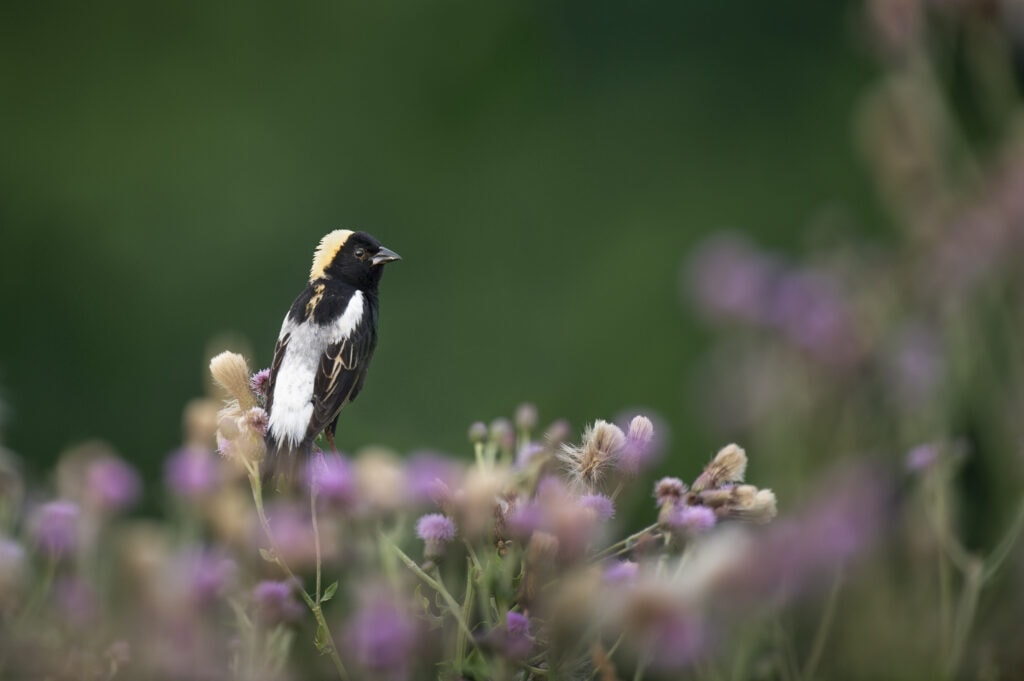The Bobolink is the snazzy singer of open grasslands and pastures throughout much of North America. This black and white bird’s yellow crest stands out amongst the crowd, as do its incredible vocals. The Bobolink is a member of the Icteridae family, which includes New World blackbirds, orioles, meadowlarks, and grackles. Many of its cousins on the Icteridae family tree are known for their singing, but only the Bobolink is named after it.
“Bobolink” comes from “Robert of Lincoln” which was shortened into “Bob o’ Link.” Robert of Lincoln is a poem by William Cullen Bryant that describes the idyllic life of the Bobolink and derives the name “Robert of Lincoln” from the sound of the Bobolink’s song. Though you may not have heard the whole poem before, the repeated phrase “bobolink, bobolink, spink, spank, spink” may be familiar.
Related Article: Species Spotlight: The Greater Roadrunner
Fun Facts About the Bobolink
Bobolinks are uniquely charming and ten to leave a strong impression on the people who live in the regions where they are found. Let’s explore some of the Bobolink’s most interesting features!
- A dapper bird in a backwards tuxedo: At first glance, the plumage of the Bobolink might seem similar to other blackbirds; mostly black feathers, some white, and a pop of color. Add to that the fact that females and non-breeding males are streaky and brown and you’ve got a very classic Icteridae look. But the Bobolink’s plumage is unique. It is the only songbird to wear a “backwards” tuxedo. Instead of a black back and a white belly, the male Bobolink has a black belly with a white back.
- A Bobolink abroad: When you think of long migrations, you probably imagine one of those wandering seabirds, like the Arctic Tern, who navigates from pole to pole each year. The Bobolink’s journey can’t quite match the Arctic Tern’s, but this unassuming songbird is a seasoned traveler. Each year, Bobolink’s migrate from the northern United States, all the way down to South America, making it as far south as Argentina to spend the winter enjoying the temperate weather.
- A poetic muse: William Cullen Bryant is not the only poet to have been inspired by the Bobolink. Emily Dickinson wrote two poems about this bird, and mentioned him in another, calling him the “Rowdy of the Meadow.” The 19th century poet John Burroughs also wrote a poem about the Bobolink.
- An appetite for rice: The scientific name of the Bobolink is “Dolichonyx oryzivorus.” “Oryzivorus” comes from the Latin words for “rice” and “to devour.” One alternate name for the Bobolink is the “Rice Bird.” It’s a fitting name, as Bobolinks must eat huge quantities of food, often rice and other grains, to prepare for their long migrations. Unfortunately, this sometimes puts them at odds with farmers.
The Future of the Bobolink
Once a ubiquitous dweller of Northeastern grasslands, the Bobolink has been in decline for the last several decades, with some conservation groups raising alarm bells in recent years over the decline of grasslands birds in general. Because they are dependent on these grasslands, land management practices are essential to the Bobolink’s survival. One particular factor that often damages Bobolink populations is the timing of mowing for agricultural land. When grasses are cut during nesting season, Bobolinks who build their nests in the grass experience widespread nest failure. Adjustments to agricultural land management may be a necessary step toward preserving the Bobolink’s future.
Popular Article: Barred Owls Are Breeding in Wyoming for the First Time

